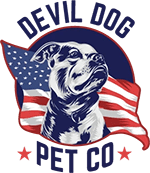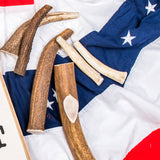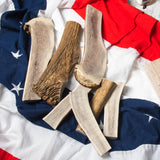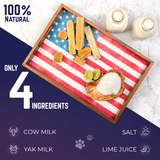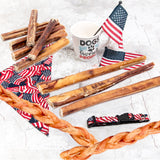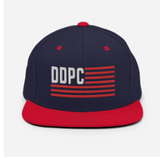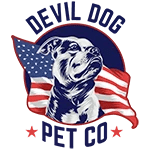Key Takeaways
- Yak chews are hard cheese sticks originating from the Himalayas.
- They are popular as durable dog chews for pets that destroy furniture.
- This guide provides an honest assessment of yak chews' safety for dogs.
- The information is presented by experienced Marine veterans familiar with pet chew trends.
Table of Contents
- Yak Chews, Decoded, What Are They and How Are They Made?
- Are Yak Chews Safe for All Dogs? Straight-Talk Risk Assessment
- Benefits of Yak Chews, Science-Backed and Marine-Vetted
- Yak Chews vs. Other Popular Chews, Side-by-Side Comparison
- How to Choose the Right Yak Chew for Your Dog, Size, Shape & Strength
Are Yak Chews Safe for Dogs? The Unfiltered Guide Every Responsible Owner Needs
If your dog's turning furniture into sawdust, you've probably heard about yak chews, those rock-hard cheese sticks from the Himalayas. But are yak chews safe for dogs? As Marine veterans who've seen every chew fad come and go, we're cutting through the marketing noise to deliver the straight truth about these ancient treats.
For owners searching for a durable, long-lasting solution, Himalayan Dog Yak Chews offer a time-tested alternative to rawhide and synthetic chews. If you have a large or power-chewing dog, consider the Monster - Himalayan Dog Chew for maximum longevity and safety.
Yak Chews, Decoded, What Are They and How Are They Made?
Yak chews aren't some modern invention, they're ancient Himalayan survival food turned dog treat. Nepalese herders have been making these protein bars for centuries using a simple three-ingredient recipe: yak and cow milk, a pinch of salt, and lime juice.
The process is pure mountain engineering. Fresh milk gets boiled down until it forms curds, then pressed into molds and smoked over yak dung fires (yes, really, it's sterile and adds that distinctive flavor dogs crave). After weeks of sun-drying at 15,000 feet, you get a rock-hard cheese stick that can survive anything your dog dishes out.
| Component | Purpose | Safety Notes |
|---|---|---|
| Yak/Cow Milk (99.9%) | Protein source, hardness | Lactose-free after drying process |
| Salt | Preservation, flavor | Minimal amount, safe for most dogs |
| Lime Juice | Coagulation agent | Neutralized during processing |
Devil Dog sources our yak chews from verified Nepalese cooperatives who've perfected this craft over generations. Every batch gets tested twice, once overseas, again at our Michigan warehouse, because when you're feeding America's dogs, there's no room for shortcuts.
Are Yak Chews Safe for All Dogs? Straight-Talk Risk Assessment

Here's the unvarnished truth: yak chews are safe for dogs when you follow basic leadership principles. These treats are fully digestible, contain zero harmful chemicals, and won't splinter like bones or rawhide. But "safe" doesn't mean "foolproof", you're still the commanding officer of this operation.
The biggest safety advantage? Complete digestibility. When your dog gnaws off small pieces, they dissolve in stomach acid like regular food. Compare that to rawhide, which can form cement-like masses, or antlers that pass through unchanged.
For more on how to select the right size and type of chew for your dog, see this guide on how to choose safe dog chews that are the right size for your dog.
Safety by Life Stage & Breed Size
- Puppies (12+ weeks): Start with oversized bars, limit to 15-minute sessions. Their developing teeth handle yak chews better than antlers.
- Adult dogs: Full green light with proper sizing. Match the bar length to your dog's muzzle, bigger is always safer.
- Seniors: Excellent choice for worn teeth. The gradual softening from saliva makes chewing easier than hard bones.
- Small breeds: Use Large or XL bars even for tiny dogs. A Yorkie can't swallow a Monster-sized yak chew.
Owner Action Plan If Problems Arise
If your dog chips a tooth: Remove the chew immediately, check for loose fragments, and schedule a vet exam within 24 hours. If they swallow a large chunk: Monitor for vomiting, loss of appetite, or straining to defecate, call your vet if any appear. If they show GI upset: Withhold the chew for 48 hours and reintroduce with shorter sessions.
Every Devil Dog yak chew gets hand-inspected before shipping. We reject bars with cracks, soft spots, or irregular density because your dog's safety isn't negotiable. That's the Marine way, attention to detail saves lives.
Benefits of Yak Chews, Science-Backed and Marine-Vetted
Yak chews aren't just entertainment, they're tools for building better dogs. The extended gnawing action scrapes plaque off teeth more effectively than quick-vanishing treats, while the mental focus required for serious chewing burns energy that might otherwise destroy your couch.
From a nutrition standpoint, you're looking at 85% protein with essential amino acids, plus calcium and phosphorus for bone health. At roughly 3.5 calories per gram, a typical 3-oz bar delivers about 300 calories spread across multiple chew sessions, making it a substantial but manageable treat when you factor portion control into daily feeding.
If your dog is a heavy chewer and you want to maximize both safety and value, the Beast - Himalayan Dog Chew is ideal for giant breeds and power chewers. For smaller dogs, the Small - Himalayan Dog Chew - 4 Pack provides the right size and hardness for safe chewing sessions.
| Component | Percentage | Benefit | Serving Size Guide |
|---|---|---|---|
| Protein | 85% | Muscle maintenance, satiety | Small (3 oz): Dogs up to 25 lbs |
| Fat | 2-4% | Low-calorie, heart-friendly | Large (5 oz): Dogs 25-60 lbs |
| Calcium/Phosphorus | 8-12% | Bone and dental health | XL (7 oz): Dogs 60-90 lbs |
| Moisture | 8-10% | Shelf stability, hardness | Beast (9+ oz): Dogs 90+ lbs |
Yak Chews vs. Other Popular Chews, Side-by-Side Comparison
Smart owners demand clarity when choosing between chews. Here's how are yak chews safe for dogs stacks up against the competition in real-world performance.
| Feature | Yak Chews | Antlers | Bully Sticks | Rawhide | Nylon Bones |
|---|---|---|---|---|---|
| Digestibility | 100% digestible | Mineral dust only | 100% digestible | Poor digestion | Indigestible |
| Odor Level | Virtually none | None | Moderate to high | Strong | None |
| Mess Factor | Light crumbs | Fine dust | Grease stains | Soggy pieces | Plastic shavings |
| Tooth Safety | Softens with saliva | Very hard | Soft, flexible | Variable | Hard plastic |
| Longevity | 1-2 weeks average | Months | 20-60 minutes | Hours to days | Weeks to months |
| Choking Risk | Low (softens) | Moderate | High (end pieces) | High (swells) | Low |
For a deeper dive into the pros and cons of other popular chews, check out this article on safe chews for dogs.
Yak Chews vs. Antlers
Best for: Dogs needing long-lasting entertainment with lower tooth risk.
Antlers win on pure durability, a single elk antler can entertain power chewers for months. But yak chews offer the sweet spot: substantial chew time without the tooth-cracking hardness that sends some dogs to emergency dental visits. Devil Dog's yak chews soften gradually with saliva, making them gentler on aging molars while still providing weeks of engagement.
Yak Chews vs. Bully Sticks
Best for: Owners wanting mess-free, long-lasting alternatives to quick-consumption treats.
Bully sticks deliver rich flavor but disappear fast, most dogs demolish a 6-inch stick in under an hour. Yak chews flip this equation: less immediate flavor payoff, but 10-20 times the entertainment duration. No grease stains on furniture, no barnyard smell lingering in your living room. For families managing multiple dogs or tight treat budgets, the math favors yak every time.
Yak Chews vs. Rawhide
Best for: Safety-conscious owners eliminating digestive blockage risks.
Rawhide's reputation speaks for itself, emergency vet visits from swollen, indigestible chunks that lodge in intestines. Yak chews dissolve completely like cheese, because that's exactly what they are. No chemical processing, no artificial hardeners, no midnight panic calls to animal hospitals. Devil Dog's yak chews give you rawhide's satisfaction without the Russian roulette.
For more information on the safety of bully sticks, read this post on are bully sticks safe for dogs.
How to Choose the Right Yak Chew for Your Dog, Size, Shape & Strength

Size matters more than you think. A properly fitted yak chew means the difference between weeks of safe entertainment and a choking hazard that disappears in one session.
Follow the muzzle rule: choose a yak chew longer than your dog's snout and thick enough that it can't fit between their back molars. A 25-pound customer's dog needs a Large (4+ inches), while a 70-pound customer's dog requires XL or Monster sizing (6+ inches).
For medium and large breeds, the Large - Himalayan Dog Chew - 1 Pack and Extra Large (XL) - Himalayan Dog Chew - 1 Pack are excellent choices to ensure safety and longevity.
Chew Life Expectancy by Size and Breed
- Small breeds (under 25 lbs): Medium yak chew lasts 2-3 weeks
- Medium breeds (25-60 lbs): Large yak chew lasts 1-2 weeks
- Large breeds (60-90 lbs): XL yak chew lasts 5-10 days
- Giant breeds/power chewers: Monster yak chew lasts 3-7 days
Aggressive chewers should size up two levels. That customer's dog who destroys tennis balls in minutes? Start with Monster, not Large. Better to overestimate and get weeks of value than undersize and watch $15 vanish in an afternoon.
For more on the traditional Himalayan cheese used in yak chews, see the Wikipedia entry on Chhurpi. And for official guidance on pet treat safety, consult the FDA's resource on pet treats and chews.
Download the FREE 10-Step Dog Prep Guide
Frequently Asked Questions
What makes yak chews different from other popular dog chews like rawhide or antlers?
Yak chews are hard, fully edible cheese sticks made from yak and cow milk, offering a digestible, low-odor alternative to rawhide and a gentler option than antlers. Unlike rawhide, they contain no chemicals and break down safely, while antlers are mineral-dense and last longer but are much harder on teeth.
Are yak chews safe for dogs with dental issues or puppies with developing teeth?
Yak chews are firmer than bully sticks but softer than antlers, making them a reasonable choice for dogs with dental sensitivity and older puppies starting to chew. However, always supervise and limit chew time to avoid tooth strain or gum irritation, especially for young or senior dogs.
How should I choose the right size and type of yak chew for my dog's breed and chewing strength?
Pick a yak chew longer than your dog's muzzle and sized to prevent swallowing large chunks. For power chewers or larger breeds, size up 1–2 levels to ensure durability and safety. Rotate chews and monitor your dog’s chewing style to adjust size and frequency accordingly.
What are the potential risks associated with yak chews and how can I minimize them?
The main risks are choking on large pieces and digestive upset from rapid marrow or cheese ingestion. Minimize these by selecting the right size, limiting chew sessions to 15–20 minutes, supervising closely, and introducing yak chews gradually, especially for dogs with sensitive stomachs or dairy sensitivities.
